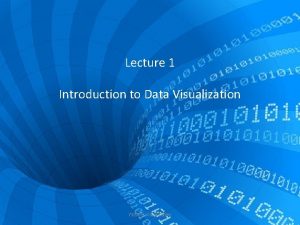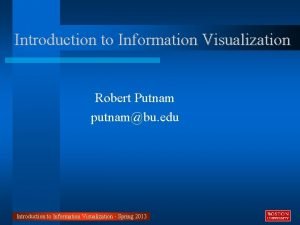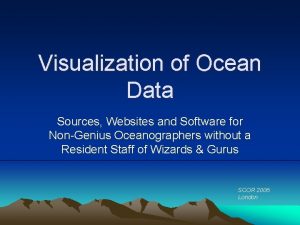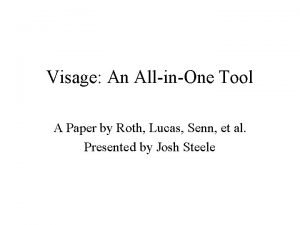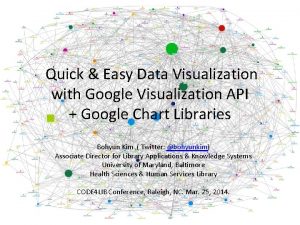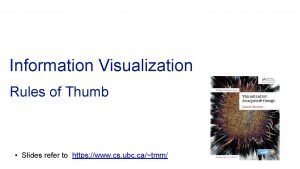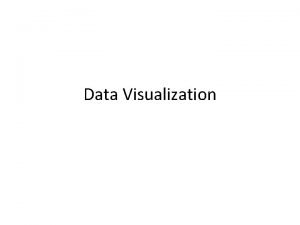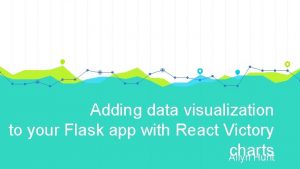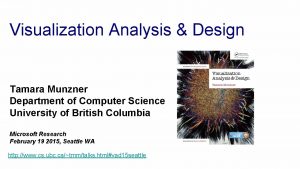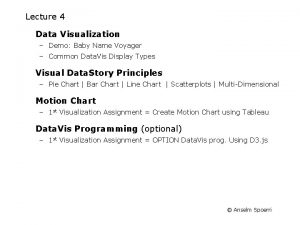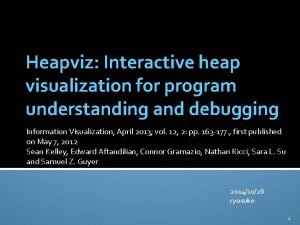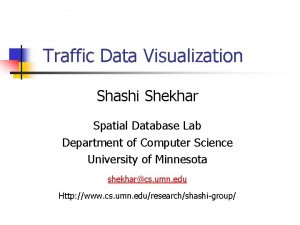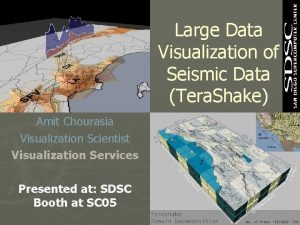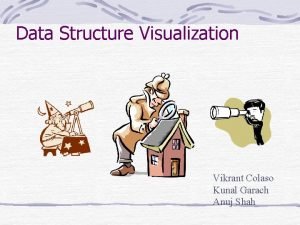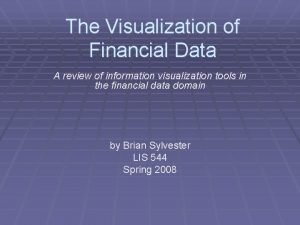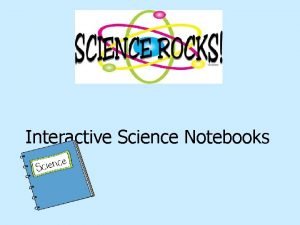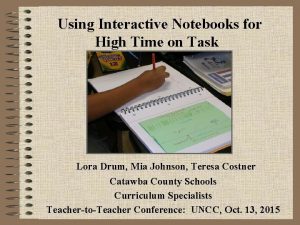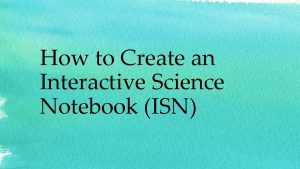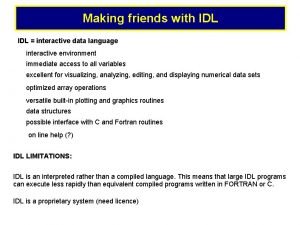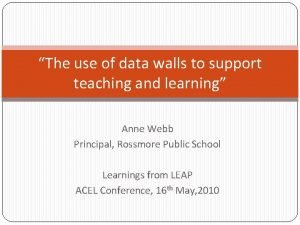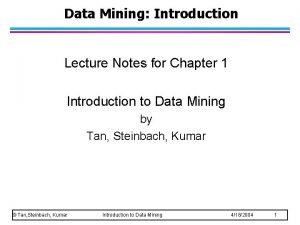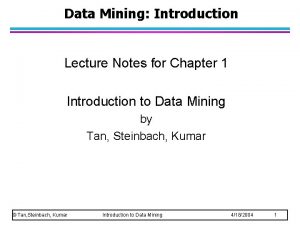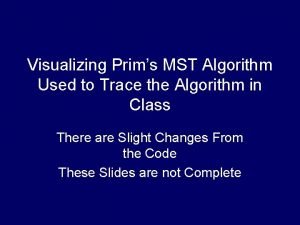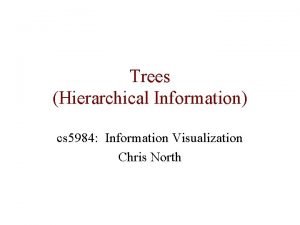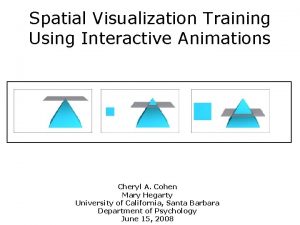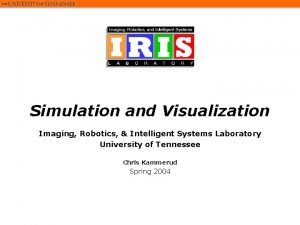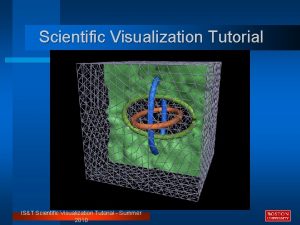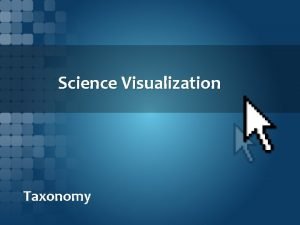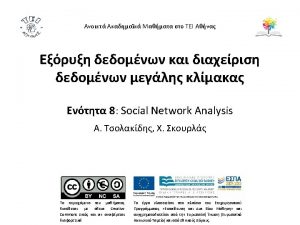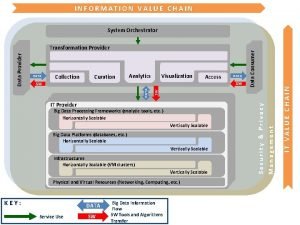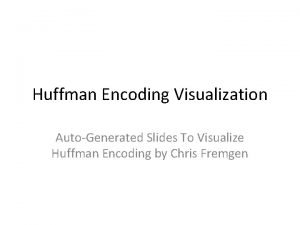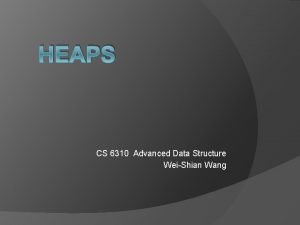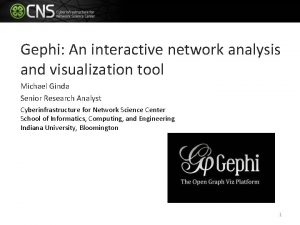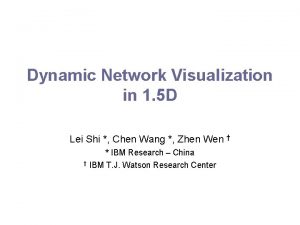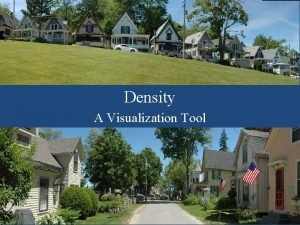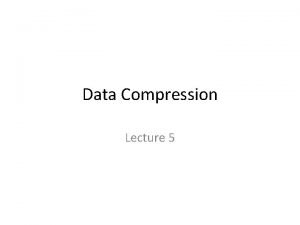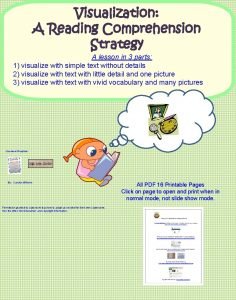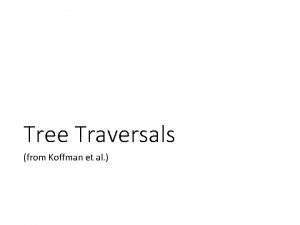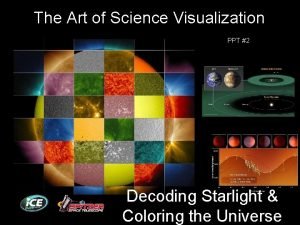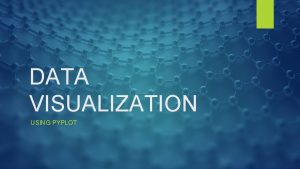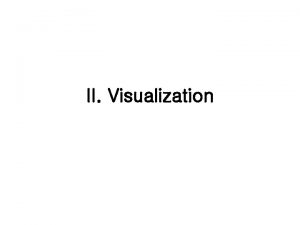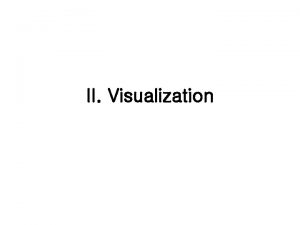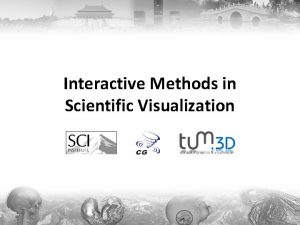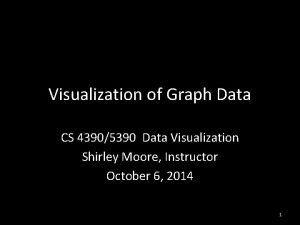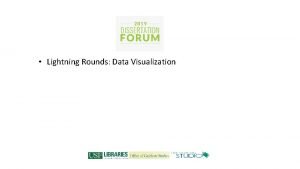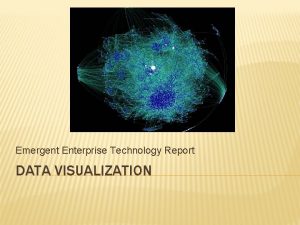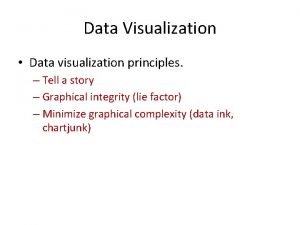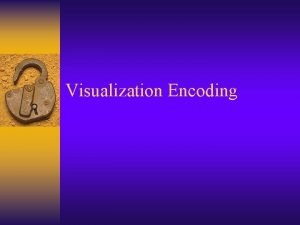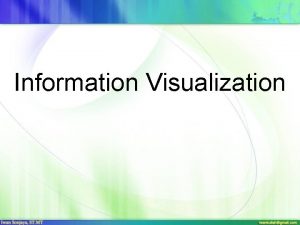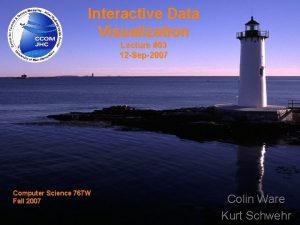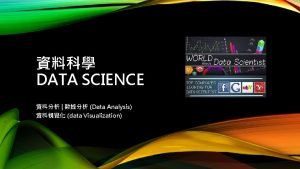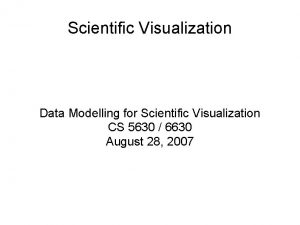Introduction to Data Science Lecture 11 Interactive Visualization

































































- Slides: 65

Introduction to Data Science Lecture 11 Interactive Visualization CS 194 Fall 2015 John Canny incorporating notes from Michael Franklin, Dan Bruckner, Evan Sparks, Shivaram Venkataraman, Maneesh Agrawala and Jeff Hamerbacher

Data Scientist’s Workflow Sandbox Production Digging Around in Data Hypothesize Model Evaluate Interpret Large Scale Exploitation

Data Scientist’s Workflow Sandbox Digging Around in Data Publish Information Hypothesize Model Evaluate Interpret

Outline Visualization: • Some great examples • Some counter-examples • Principles for Visualization Design • Visualization Toolkits preview

FIRST, A CLASSIC

Charles Joseph Minard 1869 Napoleon’s March According to Tufte: “It may well be the best statistical graphic ever drawn. ” 5 variables: Army Size, location, dates, direction, temperature during retreat

Interactivity: Baby Names Voyager (Wattenberg et al. 2005) A modern classic with rich narrative quality (i. e. you can discover stories through the names). http: //www. babynamewizard. com/

From Interactivity to Participation: Many Eyes (Wattenberg et al. 2007) Participatory visualization and explanation site: http: //www. many-eyes. com

Interactivity to Educate • The famous Gapminder Video, Hans Rosling: 200 Countries, 200 Years, 4 Minutes • https: //www. youtube. com/watch? feature=player_embedded&v=jbk. SRLYSojo

The Future of Journalism? • NY Times Interactive Visualizations (recession/recovery 2014) http: //www. nytimes. com/interactive/2014/06/05/upshot/how-the-recession-reshaped-theeconomy-in-255 -charts. html • And 2014 “the year in interactive storytelling” • http: //www. nytimes. com/interactive/2014/12/29/us/year-in-interactive-storytelling. html? _r=0 • Note: NY Times graphics are a great source of best practices in visualization.

Outline Visualization: • Some great examples • Some counter-examples • Principles for Visualization Design • Visualization Toolkits preview

Some Anti-Examples • Courtesy of WTFViz. net

Visualization to Educate? from wtfviz. net

Pie in the Sky? from wtfviz. net

from wtfviz. net

Needs Fixing from wtfviz. net

Outline Visualization: • Some great examples • Some counter-examples • Principles for Visualization Design • Visualization Toolkits preview

Visualization Definitions • “Transformation of the symbolic into the geometric” [Mc. Cormick et al. 1987] • “. . . finding the artificial memory that best supports our natural means of perception. ” [Bertin 1967] • “The use of computer-generated, interactive, visual representations of data to amplify cognition. ” [Card, Mackinlay, & Shneiderman 1999]

Uses for Data Viz A: Support reasoning about information (analysis) • • Finding relationships Discover structure Quantifying values and influences Should be part of a query/analyze cycle B: Inform and persuade others (communication) • Capture attention, engage • Tell a story visually • Focus on certain aspects, and omit others

Uses for Data Viz

Principle 1 • Simplify ! 22

Chart Design: Simplifying • Example from Tim Bray 23

Chart Design: Simplifying • Example from Tim Bray 24

Chart Design: Simplifying • Example from Tim Bray 25

Chart Design: Simplifying • Example from Tim Bray 26

Chart Design: Simplifying • Example from Tim Bray 27

Chart Design: Simplifying • Example from Tim Bray 28

Principle 1: Simplify • Tables and charts • Reduce chartjunk/tablejunk; increase data-ink ratio • Lessons from perception: Limit the number of objects displayed at once • Beware: • Gratuitous 3 D • Shadows • Gratuitous animation • How do you tell if a feature is gratuitous? Ask whether using it reveals more information. 29

Interactive Chart Design: Simplifying • With interactive charts you can keep things very simple by hiding and dynamically revealing important structure. • On an interactive chart, you reveal the information most useful for navigating the chart. 30

Principle 2: Understand Magnitudes Which is brighter?

Principle 2: Understand Magnitudes (128, 128) (144, 144) Which is brighter?

Just Noticeable Difference • JND (Weber’s Law) • Ratios more important than magnitude • Most continuous variations in stimuli are perceived in discrete steps

Steven’s Power law S = sensation I = intensity p < 1 : underestimate p > 1 : overestimate [graph from Wilkinson 99, based on Stevens 61] [alternate graph : http: //www. undergrad. ahs. uwaterloo. ca/~wchedder/stevenspowerlaw. htm]

Compare area of circles

Compare area of circles

Principle 2: Understand Magnitudes Most accurate Position (common) scale Position (non-aligned) scale Length Slope Angle Area Volume Least accurate Color hue-saturation-density

Principle 3: Use Color • Choose colors based on the information you want to convey • Sequential • Diverging • Categorical • Use online resources to discover and record your color schemes • Color Brewer • Kuler • Colour Lovers • Where possible, use your organization’s palette 38

Principle 3: Use Color • Color 39

Principle 3: Use Color • Color 40

Principle 3: Use Color • Color 41

Principle 3: Use Color • Color 42

Principle 3: Use Color • Color 43

Principle 3: Use Color • Color 44

Principle 4: Use Structure • Gestalt Psychology principles (1912): Source http: //blog. fusioncharts. com/2014/03/how-to-use-the-gestalt-principles-for-visual-storytelling-podv/ 45

Principle 4: Use Structure (but not like this) 46 Source https: //www. vocalabs. com/blog/my-dashboard-pet-peeve

Principle 4: Use Structure 47 Source https: //www. vocalabs. com/blog/my-dashboard-pet-peeve

Chart Selection – Andrew Abela

Chart Selection – Juice Analytics

Data Viz in the Sciences

Uses for Data Viz

A case for Ugly visualizations People instinctively gravitate to attractive visualizations, and they have a better chance of getting on the cover of a journal. But does this conflict with the goals of visualization? : • Rapid exploration • Focus on most important details • Easy and fast to develop and customize e. g. Powerpoint vs Keynote

Outline Visualization: • Some great examples • Some counter-examples • Principles for Visualization Design • Visualization Toolkits preview

Interactive Toolkits: D 3 Without Doubt, the most widely used interactive visualization framework is D 3, developed around 2011 by Jeff Heer, Mike Bostock and Vadim Ogievetsky. Note from the authors: D 3 is intentionally a low-level system. During the early design of D 3, we even referred to it as a "visualization kernel" rather than a "toolkit" or "framework"

Interactive Toolkits: Vega is a “visualization grammar” developed on top of d 3. js It specifies graphics in JSON format.

Interactive Toolkits: Vincent is a Python-to-Vega translator. Trivia question: why is it called Vincent? Hint: Vincent+Vega= ?

Interactive Toolkits: Vincent is a Python-to-Vega translator. Trivia question: why is it called Vincent? Hint: Vincent+Vega= ?

Bokeh: Another Interactive Viz Library Bokeh is an independent Viz library focused more heavily on big data visualization. Has both Python and Scala bindings.

Updates and Break Midterm is on 11/23, 5: 00 -6: 30 pm here. Sample midterm (Fall 2014) is online now. Project presentations on 11/30 and 12/2 (5 mins) Poster session on Wednesday 12/9 12: 30 -2: 30 pm, Here No lab this week (Veteran’s day). Viz lab next week. 5 min BREAK

Lecture Wrap-up One more lecture next week: Joey Gonzalez (co-developer of Graph. Lab at CMU and Graph. X at Berkeley) Midterm on Monday 11/23, Project presentations on 11/30.

Data Science – Our Roadmap

Contrast: Databases Data Science Querying the past Querying the future

Contrast: Machine Learning Data Science Develop new (individual) models Explore many models, build and tune hybrids Prove mathematical properties of models Improve/validate on a few, relatively clean, small datasets Publish a paper Understand empirical properties of models Develop/use tools that can handle massive datasets Take action!

Contrast: Computational Science Protein Folding Quark Raptor-X Rich, Complex Energy Models Data-intensive, general ML models Faithful, Physical Simulation Feature-based inference Conditional Neural Fields

What’s Hard (and Rewarding) about Data Science Critical Thinking: • Overcoming assumptions. • (Not) making ad-hoc explanations of data patterns. • (Not) overgeneralizing. • Checking enough (validate models, data pipeline integrity, etc. ). • Using statistical tests correctly. • If its looks weird its usually wrong, figure out why…

What’s Hard and Rewarding about Data Science Managing Complexity • Check and validate everything (again). • Prototype Production transitions. • Data pipeline complexity (who knows the entire system? ). Communicating • You have to distill the results of ###-bytes of data into a few paragraphs or a chart, and be accurate. • Models are only approximations to reality.
 Data visualization lecture
Data visualization lecture Task abstraction in data visualization
Task abstraction in data visualization 01:640:244 lecture notes - lecture 15: plat, idah, farad
01:640:244 lecture notes - lecture 15: plat, idah, farad My favorite subjects are english mathematics and science
My favorite subjects are english mathematics and science Introduction to information visualization
Introduction to information visualization Science fusion online
Science fusion online Ocean data visualization
Ocean data visualization Vli demo tool
Vli demo tool Google visualization api query language
Google visualization api query language Data visualization rules of thumb
Data visualization rules of thumb Graphics must quote data out of context
Graphics must quote data out of context Before and after data visualization
Before and after data visualization Flask data visualization
Flask data visualization Data visualization meetup
Data visualization meetup Data visualization sketch
Data visualization sketch Hitlantis
Hitlantis Tamara munzner visualization analysis and design
Tamara munzner visualization analysis and design Name voyager
Name voyager Heap data visualization
Heap data visualization Traffic data visualization
Traffic data visualization Panoramix data visualization
Panoramix data visualization Seismic data visualization
Seismic data visualization Shirley moore utep
Shirley moore utep Data structure visualization
Data structure visualization Financial data visualization tools
Financial data visualization tools Ben shneiderman data visualization
Ben shneiderman data visualization Advanced data visualization techniques
Advanced data visualization techniques Interactive science notebooks
Interactive science notebooks Interactive science notebook rubric
Interactive science notebook rubric Interactive science notebook cover design
Interactive science notebook cover design Physical science lecture notes
Physical science lecture notes Introduction to biochemistry lecture notes
Introduction to biochemistry lecture notes Introduction to psychology lecture
Introduction to psychology lecture Introduction to algorithms lecture notes
Introduction to algorithms lecture notes Interactive data language
Interactive data language What is online platforms sites and content
What is online platforms sites and content Interactive data walls
Interactive data walls Exploratory data analysis lecture notes
Exploratory data analysis lecture notes Bayesian classification in data mining lecture notes
Bayesian classification in data mining lecture notes Data mining lecture notes
Data mining lecture notes Data mining lecture notes
Data mining lecture notes Data mining lecture notes
Data mining lecture notes Introduction to data warehousing and data mining
Introduction to data warehousing and data mining Mst visualization
Mst visualization Red black tree visualization
Red black tree visualization Horspool algorithm visualization
Horspool algorithm visualization Spatial visualization training
Spatial visualization training Visualization robot simulation
Visualization robot simulation Photoshop scientific notation
Photoshop scientific notation Visualization pipeline
Visualization pipeline 2d array visualization
2d array visualization Weka visualization
Weka visualization What is shneiderman's visualization mantra?
What is shneiderman's visualization mantra? Value chain visualization
Value chain visualization Huffman coding visualization
Huffman coding visualization Pairing heap visualization
Pairing heap visualization Gephi tool
Gephi tool Ekahau visualization tags
Ekahau visualization tags Dynamic network visualization
Dynamic network visualization Visualize an acre
Visualize an acre Adaptive huffman code
Adaptive huffman code Benchmarking visualization
Benchmarking visualization Bgp route visualization
Bgp route visualization Visualization
Visualization Tree traversal visualization
Tree traversal visualization Translate
Translate
